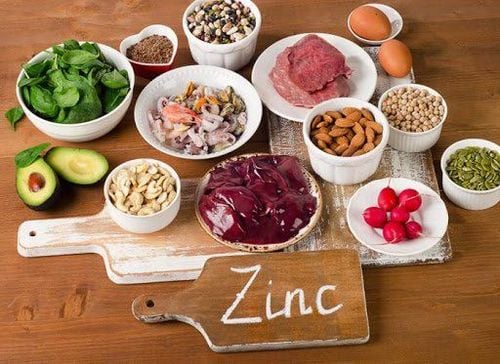This is an automatically translated article.
Helminth infections and zinc deficiency are common in low- and middle-income countries and both are known to affect child growth.
1. What is Zinc?
Zinc is a trace metal present in the brain and contributes to its structure and function. Limited evidence from animal and human studies suggests that zinc deficiency can lead to cognitive retardation. Although the mechanisms linking zinc deficiency to cognitive development are unclear, it is likely that zinc deficiency may lead to deficits in function, activity or motor development in children, and thus That interferes with cognitive functioning. Zinc is a trace mineral that plays a central role in cell growth, particularly in the production of enzymes required for RNA and DNA synthesis. Zinc is common in the brain, where it binds to proteins, thus contributing to both brain structure and function. Severe zinc deficiency in children is associated with structural abnormalities of the brain, such as anencephaly, microcephaly, and hydrocephalus with behavioral problems, such as decreased activity and mental impairment. short-term memory and spatial learning.
2. The relationship between zinc in children infected with helminths
Helminth infections and zinc deficiency are both major health problems in developing countries. Both phenomena are very common and often occur in the same individual. Although helminth infections and zinc deficiency often go unnoticed, both conditions are known to impair cognitive development and physical growth in children.
Helminth infections are often associated with malnutrition (decreased height and weight for age) and anemia (decreased hemoglobin levels) in children. Human and animal studies have shown that helminth infections also affect the micronutrient status of the host. Although helminth infections are thought to be the cause of malnutrition, malnutrition can also predispose people to infections. However, much remains to be elucidated about the mutual effects of both entities.
Specifically, poor absorption of zinc seems to predispose individuals to helminthic infections, which in turn may exacerbate nutritional deficiencies and prolong helminthic survival in humans and rodents.

Bệnh giun sán ở trẻ thường có liên quan đến suy dinh dưỡng và thiếu máu
3. How does helminth infection in children affect the body?
Childhood helminthiasis is one of the most common infections worldwide and affects the poorest and most deprived communities. They are transmitted through eggs contained in human feces and thus contaminate the soil in areas where sanitation is poor. The main species that cause disease in humans are roundworms (Ascaris lumbricoides), whipworms (Trichuris trichiura) and hookworms (Necator americanus and Ancylostoma duodenale). These helminths are often considered a group because they require similar diagnostic procedures and respond to similar drugs.
Soil-borne helminths degrade the nutritional status of those they infect in several ways:
Worms feed on host tissues, including blood, resulting in loss of zinc, iron and protein. In addition, hookworms cause chronic blood loss in the intestines, which can lead to anemia. Worms increase poor absorption of nutrients. In addition, roundworms can compete with vitamin A in the intestines. Certain types of soil-borne helminths also cause anorexia and thus reduce nutrient intake and fitness. In particular, T. trichiura can cause diarrhea and dysentery.
4. Does helminthic disease cause zinc deficiency?
Some people are not able to get the daily zinc requirement in their diet, due to parasitic worms in the child's body. Protein helps the body absorb zinc, children who eat food are not guaranteed to be infected with worms in food. Children on restricted diets and exclusively breastfed babies over 6 months can also be zinc deficient.
Zinc deficiency can occur in people who have problems absorbing nutrients, such as the elderly and people with certain intestinal diseases, infections with hairworms, pinworms, earthworms.
Sometimes babies are zinc deficient if they are born prematurely or severely ill, or if their mother has a mild zinc deficiency. Some people are born with zinc deficiency.

Trẻ thiếu kẽm sẽ gây ảnh hưởng nhiều tới sức khỏe và khả năng hấp thu dinh dưỡng
5. How to deworm children?
Deworming is the process of expelling intestinal worms or parasitic worms from the body by giving deworming drugs. In other words, it is a medical process to get rid of intestinal worms. The deworming process includes the use of dewormers.
Children's dewormers vary according to your child's age and the type of worms he or she is infected with. Treat tapeworms using an oral medication such as praziquantel (Biltricide). This medicine paralyzes and dissolves the tapeworm, which is later spread through feces.
Roundworm infections are treated using mebendazole (Vermox, Emverm) and albendazole (Albenza). Effective treatment results can be seen after a few weeks, and you should see your doctor for a re-diagnosis after the end of treatment to ensure that the deworming is done thoroughly.
Home remedies for deworming:
Make sure you establish a nutritious, balanced diet for your child that includes fruits and vegetables every day. Ginger, garlic should be included in the diet. Unhygienic food and water should be avoided, especially from outside.
6. Can zinc deficiency be prevented?
The best way to avoid zinc deficiency for most people is to eat foods that are high in zinc. These include oysters, meat and fish. Small amounts of zinc can be found in grains, legumes, dairy foods, and seeds.
Zinc deficiency can cause dangerous complications for children's health and mental health, so parents need to observe and timely supplement this important source of vitamin.
In addition to dietary supplements, parents can give their children supportive foods containing zinc and essential micro-minerals such as Lysine, chromium, selenium, vitamin B... to help fully meet their needs. nutritional requirements in children. At the same time, these essential vitamins also support digestion, enhance nutrient absorption, help improve anorexia, and help children eat well.
Please regularly visit Vinmec.com website and update useful information to take care of your baby and family.













